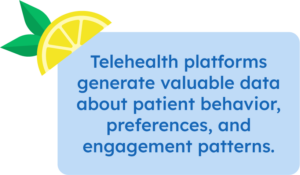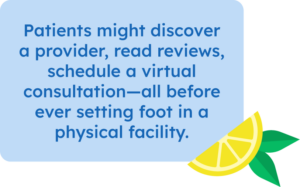The healthcare landscape has been drastically transformed by telehealth adoption, and the numbers tell a compelling story. The global telehealth market has experienced explosive growth, with projections showing the market will expand from $186.41 billion in 2025 to $791.04 billion by 2032—representing a remarkable 22.9% compound annual growth rate.
But here’s the question that should keep healthcare marketing professionals awake at night: Are you prepared for what this growth really means for patient acquisition?
While these numbers represent unprecedented opportunities, they also signal complex challenges that could completely reshape how patients find, evaluate, and choose their healthcare providers.
The Patient Acquisition Playbook Just Got Rewritten
Let’s be honest about what’s happening here. Telehealth hasn’t just added another service option—it’s fundamentally altered how patients discover, evaluate, and engage with healthcare providers. The shift toward digital-first healthcare experiences means that traditional patient acquisition models aren’t just outdated; they’re being rewritten in real-time.
Think about it: patients now expect the same level of convenience and accessibility they experience in other industries. And why shouldn’t they?
This evolution has created entirely new touchpoints in the patient journey. Where once a patient might have called a clinic directly or relied solely on referrals, they now research providers online, read reviews, and often prefer to schedule virtual consultations as their first point of contact. This shift has made digital presence and online reputation management more critical than ever for healthcare organizations looking to attract and retain patients.
The convenience factor cannot be overstated. Telehealth eliminates traditional barriers like travel time, parking hassles, and time away from work. These are all factors that often deter patients from seeking care or trying new providers. But here’s what’s really interesting: for healthcare marketers, this means that geographic constraints are less limiting, but it also means competition has intensified as patients can now easily access providers outside their immediate vicinity.
So the question becomes, how do you stand out when your competition just expanded exponentially?
The Opportunities Are Real (If You Know How to Capture Them) 
Geographic Boundaries
One of telehealth’s most significant advantages is its ability to extend healthcare services beyond traditional geographic boundaries. Rural and underserved populations, who previously faced substantial barriers to accessing specialized care, can now connect with providers virtually. This expansion creates opportunities for healthcare organizations to tap into previously unreachable patient populations.
The data supports this trend. Cloud-based telehealth services are projected to grow at the fastest rate through 2030, driven by advancements in smartphone technology and improvements in internet connectivity in remote locations. For patient acquisition, this means healthcare organizations can build relationships with patients who might never have been able to visit their physical locations.
But here’s what many organizations miss: it’s not just about reaching more people. It’s about reaching the right people who value what you uniquely offer.
The Economics Actually Work (When Done Right)
Telehealth offers a more cost-effective way to engage with both new and existing patients. Virtual consultations reduce overhead costs associated with in-person visits while allowing providers to see more patients in a day. This efficiency can translate into more competitive pricing and improved patient satisfaction—two key factors in patient acquisition and retention.
The cost benefits extend to patients as well. Reduced travel costs and time away from work make healthcare more accessible, which can be a significant differentiator when patients are choosing between providers. Healthcare marketers can, and should, leverage these cost savings as part of their value proposition.
Patient Experience Becomes Your Competitive Advantage
It should come as no surprise that today’s patients increasingly value convenience and flexibility in their healthcare experiences. Telehealth directly addresses these preferences by offering appointment scheduling flexibility, reduced wait times, and the comfort of receiving care from home. These improvements in patient experience can lead to higher satisfaction scores, better online reviews, and increased word-of-mouth referrals—all crucial components of organic patient acquisition.
The ability to offer immediate or same-day virtual consultations can be particularly powerful for urgent care scenarios and mental health services, where timely access to care is often a deciding factor for patients choosing a provider.
The Data Goldmine You Didn’t Know You Had
 Telehealth platforms generate valuable data about patient behavior, preferences, and engagement patterns. This information can be a goldmine for healthcare marketers looking to refine their patient acquisition strategies. Understanding when patients prefer to schedule appointments, which services they’re most likely to use virtually, and how they interact with digital health tools can inform more targeted and effective marketing campaigns.
Telehealth platforms generate valuable data about patient behavior, preferences, and engagement patterns. This information can be a goldmine for healthcare marketers looking to refine their patient acquisition strategies. Understanding when patients prefer to schedule appointments, which services they’re most likely to use virtually, and how they interact with digital health tools can inform more targeted and effective marketing campaigns.
The Challenges Are Significant (And They’re Not Going Away)
The Digital Divide
Despite rapid advancement, significant barriers remain in telehealth adoption. Infrastructure limitations, particularly in rural areas, continue to hinder widespread implementation. Many potential patients lack reliable high-speed internet access or the devices necessary for quality telehealth interactions. This digital divide can limit the reach of telehealth-based patient acquisition strategies.
Healthcare organizations also face their own technology challenges. Limited health information exchange capabilities and difficulties integrating telehealth platforms with existing electronic health records can create operational complexities that impact patient experience and, ultimately, patient acquisition efforts.
Regulatory Complexity
The regulatory landscape for telehealth remains complex and evolving. Licensing requirements across state lines, varying reimbursement policies, and compliance concerns create additional layers of complexity for healthcare organizations looking to expand their telehealth offerings. These regulatory hurdles can limit patient acquisition opportunities and require significant resources to navigate effectively.
Reimbursement policies, while more favorable than pre-pandemic levels, still vary significantly between insurance providers and can affect the financial viability of telehealth services. This uncertainty can make it challenging for healthcare organizations to develop sustainable strategies around virtual care.
Not Everyone Is Ready for the Digital Revolution
Not all patients are comfortable with or capable of using telehealth technology effectively. Digital literacy varies significantly across patient populations, with older adults and certain socioeconomic groups facing particular challenges. Healthcare organizations must invest in patient education and support to ensure successful telehealth adoption, which can increase patient acquisition costs and complexity.
The usability of telehealth applications remains a significant obstacle. Many patients encounter difficulties navigating these platforms, which can lead to frustration and potentially drive them to seek care elsewhere. For patient acquisition purposes, a poor initial telehealth experience can be particularly damaging, as first impressions often determine whether a patient will return or recommend the provider to others.
What This Means for Healthcare Marketing (Spoiler: Everything Changes) 
Successful patient acquisition in the telehealth era requires a deep understanding of the patient journey across multiple touchpoints. Patients might discover a provider through online search, read reviews on multiple platforms, schedule a virtual consultation, and then decide whether to continue the relationship—all before ever setting foot in a physical facility.
This complexity makes reputation management more critical than ever. Online reviews and ratings carry increased weight when patients can’t rely on physical cues like facility appearance or in-person staff interactions to evaluate providers. Healthcare organizations need robust systems for monitoring and managing their online presence across all platforms where patients might encounter them.
The ability to gather and act on patient feedback also becomes crucial in this environment. Understanding what patients value most about their telehealth experiences (whether it’s ease of scheduling, provider communication style, or technical platform reliability) can inform both service improvements and marketing messaging.
What Comes Next?
As we move deeper into 2025, the integration of artificial intelligence into telehealth platforms promises to further transform patient acquisition strategies. AI-powered chatbots for initial patient screening, predictive analytics for identifying high-value patients, and personalized care recommendations are already beginning to reshape how healthcare organizations attract and engage patients.
The key to success in this evolving landscape lies in viewing telehealth not as a separate service offering but as an integral part of a comprehensive patient experience strategy. Organizations that can seamlessly blend virtual and in-person care while maintaining high levels of patient satisfaction will be best positioned to thrive in the competitive healthcare marketplace.
The Questions You Should Be Asking
 For healthcare marketing and patient experience professionals, staying ahead of these trends requires continuous learning and adaptation. As you think about your organization’s approach to telehealth and patient acquisition, consider:
For healthcare marketing and patient experience professionals, staying ahead of these trends requires continuous learning and adaptation. As you think about your organization’s approach to telehealth and patient acquisition, consider:
- How well do you really understand your patients’ digital preferences and capabilities?
- Are you measuring the right metrics to understand telehealth’s impact on patient acquisition?
- Is your organization prepared to compete in a market where geographic boundaries matter less?
- How effectively are you integrating patient feedback from virtual encounters into your overall patient experience strategy?
Understanding these dynamics and having the right tools to measure and respond to patient feedback across all touchpoints—virtual and physical—will be essential for healthcare organizations looking to maximize their patient acquisition potential in the telehealth era.
Because ultimately, the organizations that succeed won’t be those with the most advanced technology or the biggest marketing budgets. They’ll be the ones who best understand what their patients truly value and deliver experiences that exceed those expectations, whether that’s through a screen or face-to-face.
The telehealth revolution isn’t coming. It’s here. The question is: Are you ready to make the most of it?











